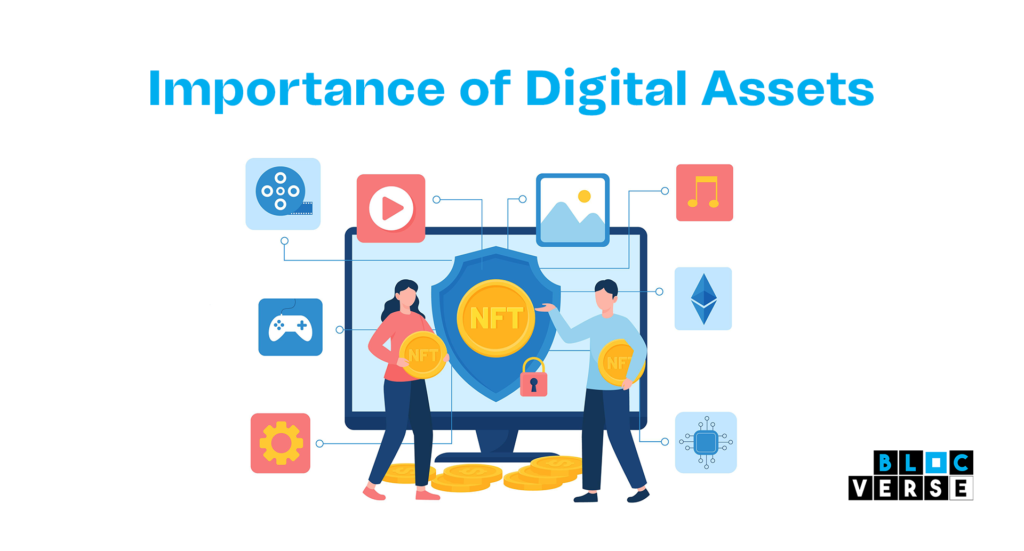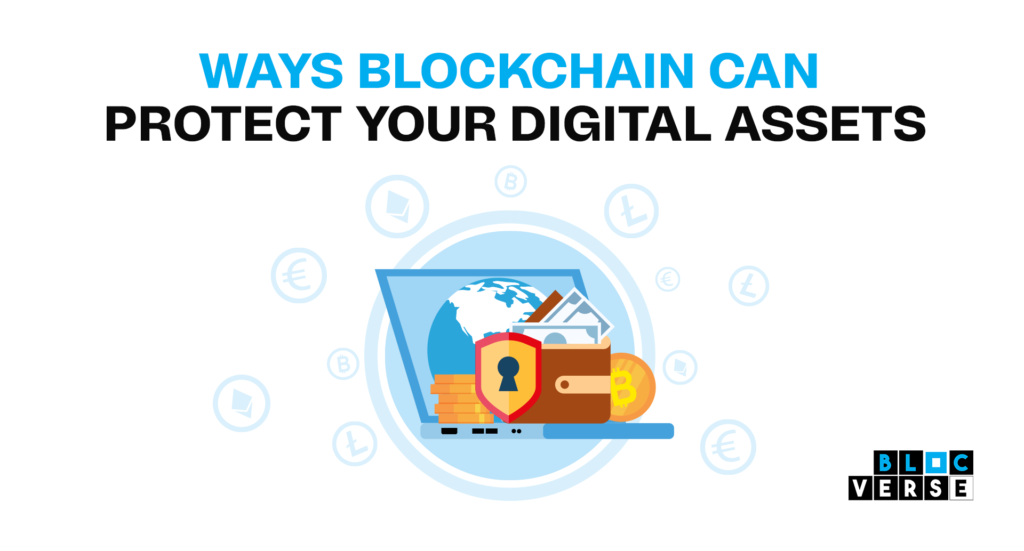Blockchain technology creates a data structure with built-in security features. Its foundations are based on consensus, decentralization, and cryptographic principles, all supporting transaction confidence.
It would be best if you had a better understanding of blockchain technology’s architecture and how it can assist in protecting our digital assets after reading this article.
Outline
- What is blockchain
- What are digital assets
- Digital assets in Blockchain technology
- What makes digital assets so important
- Security risks faced by digital assets
- Five ways blockchain can protect your digital assets
- Conclusion
What Is Blockchain?
A blockchain is a digital ledger that records transactions and is protected against hacking and manipulation by a network of computers.
With the help of blockchain technology, people may transact securely between themselves without the need for a middleman like a bank, government, or another third party.
After learning about blockchain technology, it is clear that the platform’s structure revolves around security, namely, how to protect our digital assets.
The structure of blockchain technology revolves around security or how to keep our digital assets safe.
Now that we better understand what it means, we will look into digital assets’ meaning.
What Are Digital Assets?
Digital assets are files created electronically and kept as data on a computer system or digital storage disk. A painting or a set of handwritten notes can become a digital asset by being scanned and transferred to a computer.
Examples of digital assets
Digital assets include:
- Images
- design files
- videos
- PDFs
- Presentations
- Word documents
- corporate branding
- marketing materials and content
- 3D files
It’s vital to remember that the file format is only one component of the definition of a digital asset, which is constantly evolving as new digital formats are adopted by businesses.
Any individual file can become a digital asset by meeting three essential criteria.
An online asset has to :
- Be a digital file that belongs to a person or business
- Serve that person or business
- Be found and searched for (usually with metadata).
Digital Assets In Blockchain Technology

Cryptocurrencies and tokens are the two digital assets most frequently used with blockchain technology. The use of cryptography, a sophisticated encryption technology that ensures the legitimacy of crypto assets by eliminating the potential of counterfeiting or double-spending, distinguishes cryptocurrency and tokens as distinct subclasses of digital assets.
Cryptocurrencies
A cryptocurrency is a digital asset you can trade, use as a means of exchange, and keep as a store of value on a blockchain network.
A cryptocurrency is often referred to as a blockchain’s native currency because the blockchain protocol on which it operates directly issues them.
Cryptocurrencies are frequently used to reward users for maintaining the security of the cryptocurrency’s network. You can also use it to pay transaction fees on the network. They are also referred to as coins.
Tokens
Tokens, also known as crypto tokens, are units of value that blockchain-based initiatives or organizations create on top of already-existing blockchain networks.
Despite frequently having close compatibility with the coins of that network, they belong to another category of digital assets.
Tokens are produced by platforms built on top of specific blockchain protocols, whereas cryptocurrencies are the native asset of a given blockchain protocol.
For instance, the native token of the Ethereum blockchain is called ether (ETH). Although ether is the token native to the Ethereum network, other distinct tokens also use it.
These tokens can perform a wide range of tasks on the platforms for which they are designed, such as accessing platform-specific services, participating in decentralized finance (DeFi) procedures, and even playing games.
Examples of digital assets in Blockchain technology include
- Bitcoin
- Ethereum
- Cardano
- Solana
- Polkadot
- Dogecoin
- Non-fungible tokens (NFTs)
What Makes Digital Assets So Important?

Establishing a strong connection with your customer is necessary to conduct a successful commercial transaction.
Most of these connections take place over internet platforms in today’s increasingly digital environment, where your digital assets come into play. Digital assets are, at their heart, a visual depiction of your company’s goods, services, culture, and, ultimately, your brand.
Digital assets are the primary forces behind online engagement because they serve as a conduit between your business and your clients, enabling you to communicate with them however you like, whenever you want, and wherever you like. Your digital assets must be valuable, though, for them to be that significant, and this is only possible if they are discoverable (if they can be found).
When managing many digital assets, it’s crucial to take the necessary precautions to ensure they are discoverable and manageable. This precaution is typically accomplished by employing a sensible taxonomy (category structure) and consistent metadata (keywords, titles, photographer name, etc.)
Security Risks Faced By Digital Assets

There are so many risks associated with securing digital assets, some of which include
Loss Of Data
Data leaks are persistent, and they might attack your digital assets. When a third party accesses your asset without your permission and copies, transmits, or displays it without your knowledge, this is known as a “data breach.”
An incident involving a data breach that affected almost one million accounts happened once at the well-known company Ledger, which develops wallets for digital assets.
Phishing Attacks
Phishing attacks are a popular technique used by threat actors to obtain user data despite internet users today being more aware of phishing. These attacks have been expected for a while, and cybercriminals have learned to pick innocent individuals as their targets.
Phishing attempts to fool you into installing malware on your system, beginning with a malicious email or email attachment. For instance, a hacker may take your username and password for the digital wallet platform where you keep your cryptocurrency holdings.
Ransomware
Ransomware attacks are another frequent type of hack. Your data is encrypted by this kind of software, making it difficult to access unless you pay the cybercriminal a steep fee. One of your digital assets might be encrypted by a cyberthief, who would then deny you access to it unless you made a payment.
Five Ways Blockchain Can Protect Your Digital Assets

Blockchain security is a complete risk management solution for blockchain networks that incorporates assurance services, cybersecurity standards, and best practices to reduce the risks of fraud and cyberattacks. It would be best if you took precautions to protect your digital assets because they are valuable and are subject to numerous security risks, some of which were discussed above.
Here are a few methods by which blockchain technology protects digital assets:
Cryptography
Data may be encrypted and decrypted using the science of cryptography, allowing users to store sensitive information or send it over insecure networks where only the intended receiver can access it. Plain text is masked, and its content is hidden through encryption, preventing a cyberattack.
Decentralized Structure
The ledger system is decentralized, which means that information is transparently accessible to participants on the particular blockchain. Any transactional data encrypted and stored on its blockchain can be recorded, sent, and viewed by all members (or nodes).
While preserving a high level of data integrity, this method builds confidence. Fundamentally, the distributed structure of blockchain eliminates any “hackable” entry or point of failure that could jeopardize the confidentiality of whole datasets.
Transparency
There is no need for a password to access the transparent ledger. The ledger can create a single-source, impenetrable form of entry into any private data using biometrics, such as fingerprints and retina scans.
Decentralized Storage
Using decentralized storage reduces the amount of data that may be compromised by ensuring that each block only includes a little portion of a much larger puzzle.
Public Record-keeping System
Every node on the blockchain has access to the public record-keeping system, which allows it to track any data alteration and identify potential cyberattack attempts in real-time.
Conclusion
The number of distinctive digital assets will increase as the blockchain industry develops, meeting the diverse needs of all ecosystem members, from business partners to end consumers.
There are fewer restrictions on creating new assets in the digital world than in the physical one. When you protect these digital assets, it is expected that they will enhance the function, interaction, and general value of many industries, opening up a vast array of new social and economic opportunities.

